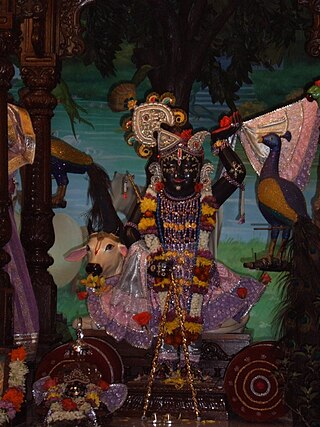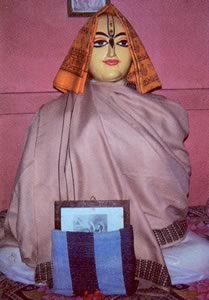
Chaitanya Mahaprabhu was a 15th-century Indian saint who is considered to be the combined avatar of Radha and Krishna by his disciples and various scriptures. Chaitanya Mahaprabhu's mode of worshipping Krishna with bhajan-kirtan and dance had a profound effect on Vaishnavism in Bengal. He was also the chief proponent of the Vedantic philosophy of Achintya Bheda Abheda Tattva. Mahaprabhu founded Gaudiya Vaishnavism. He expounded Bhakti yoga and popularized the chanting of the Hare Krishna Maha-mantra. He composed the Shikshashtakam.

Gaudiya Vaishnavism, also known as Chaitanya Vaishnavism, is a Vaishnava Hindu religious movement inspired by Chaitanya Mahaprabhu (1486–1534) in India. "Gaudiya" refers to the Gaura or Gauḍa region of Bengal, with Vaishnavism meaning "the worship of Vishnu". Specifically, it is part of Krishnaism—Krishna-centric Vaishnavite traditions.

Narottama Dasa Thakura, also known as Thakura Mahasaya, was a Gaudiya Vaishnava saint who was responsible for spreading Vaishnava bhakti throughout Odisha in and outside of Bengal in India. Narottama Dasa was the son of King Krishnananda Datta and Narayani Devi who resided in Gopalpur Pargana of the Rajshahi district of Bangladesh. According to some, after the death of his father he entrusted his royal duties to the eldest paternal uncle's son and left for Vrindavana.
The Chaitanya Charitamrita, composed by Krishnadasa Kaviraja in c. 1557, is written in Bengali with a great number of Sanskrit verses in its devotional, poetic construction, including Shikshashtakam. It is one of the primary biographies detailing the life and teachings of Caitanya Mahāprabhu, the founder of Gaudiya Vaishnavism. The stories of Chaitanya's life are mixed with philosophical conversations detailing the process of Bhakti yoga, with special attention given to congregational chanting of Krishna's names and the Hare Krishna mantra.

Rupa Goswami was a devotional teacher (guru), poet, and philosopher of the Gaudiya Vaishnava tradition. With his brother Sanatana Goswami, he is considered the most senior of the Six Goswamis of Vrindavan associated with Caitanya Mahaprabhu, a hidden avatar (incarnation) of Krishna in Kali Yuga.

Sanatana Goswami was a principal follower of Chaitanya Mahaprabhu. Sanatana wrote a number of important works in the bhakti tradition of Gaudiya Vaishnavism and was the seniormost of the influential Six Goswamis of Vrindavan, among whom was his brother Rupa Goswami.

Jiva Goswami was an Indian philosopher and saint from the Gaudiya Vaishnava school of Vedanta tradition, producing a great number of philosophical works on the theology and practice of Bhakti yoga, Vaishnava Vedanta and associated disciplines. He is known as one of the Six Goswamis of Vrindavan and was the nephew of the two leading figures, Rupa Goswami and Sanatana Goswami.

Pancha Tattva in the Gaudiya Vaishnava tradition of Hinduism refers specifically to the Five aspects of God or Absolute Truth.
Raghunatha Bhatta Goswami (1505–1579) was a well known follower of the Vaishnava saint Chaitanya Mahaprabhu, and member of the influential Gaudiya Vaishnava group collectively known as the Six Goswamis of Vrindavan. He is regarded by followers in the Gaudiya tradition as an ideal practitioner of the Bhakti yoga system.

Gopala Bhatta Goswami (1503–1578) is one of the foremost disciples of the Vaishnava saint, Chaitanya Mahaprabhu, and a leading historical figure in the Gaudiya Vaishnava school of Hinduism. He was part of a group of Vaishnava devotees known collectively as the Six Goswamis of Vrindavan, who were influential in establishing the philosophical basis of the Gaudiya tradition in formalised writings.

Madhavendra Puri also known as Madhavendra Puri Goswami is a Vaishnava saint who appeared in the 14th century. He was initiated in to Dvaita Vedanta of Madhvacharya of Udupi region of Karnataka, was highly revered in Chaitanya Mahaprabhu's Gaudiya Vaishnavism

Haridasa Thakur was a prominent Vaishnava saint known for being instrumental in the initial propagation of the Hare Krishna movement. He is considered to be the most famous convert of Chaitanya Mahaprabhu, apart from Rupa Goswami and Sanatana Goswami. His story of integrity and unflinching faith in the face of extreme adversity is told in Chaitanya Charitamrita, Antya lila. It is believed that Chaitanya Mahaprabhu himself designated Haridasa as nāmācarya, meaning the 'teacher of the Name'. Haridasa Thakura, was a devotee of God, Krishna, and had practiced chanting the names of the Lord, Hare Krishna, 300,000 times daily.

ISKCON Vrindavan, also called Sri Sri Krishna Balaram Mandir, is one of the major ISKCON temples in the world. It is a Gaudiya Vaishnava temple located in the city of Vrindavan, Mathura district, in the Indian state of Uttar Pradesh. The temple is dedicated to the Hindu gods Krishna and Balarama. The other deities of temple are Radha Krishna and Gauranga Nityananda.
Sat Sandarbhas is a 16th-century Vaishnava Sanskrit text, authored by Gaudiya Vaishnava theologian Jiva Goswami. The six treatise are Tattva-, Bhagavat-, Paramatma-, Krishna-, Bhakti-, and Priti-sandarbha. Jiva's Krama-sandarbha commentary on the Bhagavata Purana is often described as the "seventh" of the six sandarbhas.
The Six Goswamis of Vrindavan were a group of devotional teachers (gurus) from the Gaudiya Vaishnava tradition of Hinduism who lived in India during the 15th and 16th centuries. They are closely associated with the land of Vrindavan where they spent much time in service of Sri Chaitanya Mahaprabhu, who is considered as Krishna's yuga-avatar by the Gaudiya Vaishnava lineage, who highly regard them for their extreme renunciation of physical comforts and pleasures in the practice of Bhakti Yoga, and for their philosophical presentations of the teachings of their guru, Chaitanya Mahaprabhu.

Sri Radha Raman Temple, is a Hindu temple situated in Vrindavan, India. It is dedicated to Krishna who is worshiped as Radha Ramana. This temple is counted as one of the Seven most revered ancient temples of Vrindavan along with Radha Vallabh Temple, Radha Damodar Temple, Radha Madanmohan Temple, Radha Govindji Temple, Radha Shyamsundar Temple and Radha Gokulnandan Temple. The temple houses the original Shaligram deity of Krishna alongside goddess Radha.

The Advaita Parivāra is the succession of disciples descending from Śrī Advaita Ācārya, the joint avatāra of Śrī Sadāśiva and Mahāviṣṇu. It is one of the main branches of the Gauḍīya Vaiṣṇava sampradaya, which started with Śrī Caitanya Mahāprabhu.

Dr. Satyanarayana Dasa is an Indian Gaudiya Vaisnava scholar and practitioner. Dasa is a polymath, holding a Ph.D. in Sanskrit from Agra University, a degree in Indian law from Agra University, a Bachelors of Technology in Mechanical engineering from the Indian Institute of Technology and a Masters of Technology in Industrial Engineering from the Indian Institute of Technology. Currently based in India at the Jiva Institute, which he founded, Dasa has published numerous books and original papers in the field of Gaudiya Vaisnavism including translations and commentaries on the Sat Sandarbhas. His honors include an award from the President of India in 2012. Dasa has been called a leading living practitioner-scholar of Jīva Gosvāmin.

Shri Haridas Shastri (1918-2013) was an Indian Gaudiya Vaisnava scholar and practitioner. A prolific Sanskrit scholar, he wrote more than a sixty books, including translations from the Sanskrit of several Gauḍīya books and his own commentaries on them. His original works include the highly regarded book, the Vedānta-darśanam bhāgavata bhāṣyopetam, his translation-cum-commentaries of the Sat Sandarbhas, and his transliterations of Śrī-caitanya-bhāgavata, Śrī-caitanya-caritāmṛta and Śrī-caitanya-maṅgala. Jonathan Edelmann at the University of Florida has called Śāstrī "arguably the most prolific and well-educated Gauḍīya Vaiṣṇava “insider” scholar of the twentieth century" and "a voice distinct from the more well known Gaudīya-Maṭha and ISKCON". Among his disciples is the noted Gauḍīya scholar and practitioner, Dr. Satyanarayana Dasa.

Shri Radha Damodar Temple is a Hindu temple dedicated to Hindu deities Radha and Krishna. The temple is situated in Vrindavan of Indian state Uttar Pradesh. In the temple, Krishna is worshiped in the form of Damodar with his consort Radha. It is one of the main seven Goswami temples of Vrindavan. The temple belongs to Gaudiya Vaishnavism tradition and was founded by Jiva Goswami in 1542 CE.














